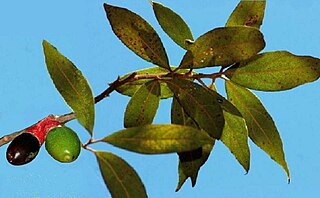
Chrysobalanaceae is a family of flowering plants, consisting of trees and shrubs in 27 genera and about 700 species of pantropical distribution with a centre of diversity in the Amazon. Some of the species contain silica in their bodies for rigidity and so the mesophyll often has sclerenchymatous idioblasts. The widespread species Chrysobalanus icaco produces a plum-like fruit and the plant is commonly known as the coco plum.

Euploea klugii, the brown king crow or king crow, is a butterfly from the family Nymphalidae found in India and Southeast Asia. The species was first described by the entomologist Frederic Moore in 1858.

Richeria grandis is a tree species in the family Phyllanthaceae which ranges from the Lesser Antilles to South America. The species is reputed to have aphrodisiac properties.
Parinari argenteo-sericea is a tree of Borneo in the family Chrysobalanaceae. The specific epithet argenteo-sericea is from the Latin meaning "silvery silky", referring to the pubescence of the inflorescence and flowers.

Parinari is a genus of plant in the family Chrysobalanaceae.

Parinari curatellifolia is an evergreen tropical tree of Africa, found in various types of deciduous woodland most frequently in poorly drained areas and inland at moderate altitudes. It is also known as mmupudu, mupundu or mobola plum after the fruit, which is considered tasty and causes the tree to be spared when woodland is cleared for cultivation.

The Sanje mangabey is a highly endangered Old World monkey of the white-eyelid mangabey group from the Eastern Arc Mountains in Tanzania. They are about 50–65 centimetres (20–26 in) in length, excluding the tail, and their body colour is greyish. Fruit makes up about 70% of their diet. They live in valley forests and on mountain slopes, but are mostly ground-dwelling, which makes them susceptible to hunting and poaching. Their habitat is being degraded, and the International Union for Conservation of Nature has assessed their conservation status as being "endangered".

Leptoglossus zonatus is a species of leaf-footed bug, a type of true bugs. It is found throughout much of South America, Central America, Mexico, and the southwestern United States. The bug is two centimeters in length, gray in color, with a zigzagging whitish band across its back and two distinctive yellowish spots on its anterior pronotum, the identifying characteristic for the species.

Heliophisma klugii is a species of moth of the family Noctuidae first described by Jean Baptiste Boisduval in 1833. It is found in Africa, including West Africa, Madagascar, Sierra Leone and South Africa.

Endlicheria is a neotropical plant genus consisting of approximately 60 species, occurring mostly in northern South America and the Amazon region. Most species are medium-sized trees, sometime up to 40 metres in height, but a few species are shrubs. DNA molecular data shows that it is closely related to Rhodostemonodaphne and Ocotea.
Parinari campestris is a species of tree in the plant family Chrysobalanaceae which is native to Trinidad, the Guianas, Venezuela and Brazil. It is reputed to have aphrodisiac properties.

Parinari excelsa, the Guinea plum, is a species of large, evergreen tree in the family Chrysobalanaceae. It has a very wide distribution in tropical Africa and the Americas. This species grows to 50 m (160 ft) tall while the trunk is up to 1.5 m (5 ft) in diameter.

Parinari capensis, the sand apple, is a species of flowering plant in the family Chrysobalanaceae, found in Botswana, DRC, Mozambique, Namibia, South Africa, Tanzania and Zimbabwe. It is 20 centimetres (7.9 in) tall. The leaves are elliptic with a white underside. It has small white flowers and a hairy sand-coloured calyx.
Parinari canarioides is a tree in the family Chrysobalanaceae. The specific epithet canarioides is for the species' resemblance to the genus Canarium.
Parinari elmeri is a tree in the family Chrysobalanaceae. It is named for the American botanist Adolph Elmer.
Parinari metallica is a tree in the family Chrysobalanaceae. The specific epithet metallica is from the Latin meaning "metallic', referring to the metallic sheen on the leaves when dried.
Parinari oblongifolia is a tree in the family Chrysobalanaceae. The specific epithet oblongifolia is from the Latin meaning 'oblong-leafed'.

Glomeris klugii is a species of pill millipede within the genus Glomeris and family Glomeridae. The species is highly variable in colouration, with more than 40 varieties and subspecies identified, each displaying unique colour patterns. The diverse colour patterns of G. klugii can be visually striking, and certain patterns are geographically restricted, leading to the species being associated with numerous taxonomic synonyms.
Parinari occidentalis is a species of tree in the family Chrysobalanaceae. It is native to South America.

Dasymutilla klugii, also known as Klug's velvet ant, is a species of velvet ant. Found in south-central North America from Utah to Puebla, it is the most commonly encountered velvet ant in Texas. Velvet ants are actually parasitic wasps, among the species used by D. klugii used to incubate their young are cicada-killer wasps.













